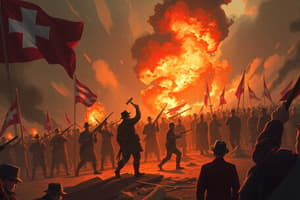Podcast
Questions and Answers
Which of the following was a primary reason European countries used their colonies during World War I?
Which of the following was a primary reason European countries used their colonies during World War I?
- To recruit soldiers and extract resources to support the war effort. (correct)
- To establish new administrative centers away from European conflict.
- To relocate their populations in anticipation of widespread destruction.
- To serve as neutral negotiation zones between warring European powers.
Germany's invasion of which country directly caused Great Britain to enter World War I?
Germany's invasion of which country directly caused Great Britain to enter World War I?
- Belgium (correct)
- Russia
- Poland
- France
Which of the following best describes the strategic impact of the Schlieffen Plan on the course of World War I?
Which of the following best describes the strategic impact of the Schlieffen Plan on the course of World War I?
- It successfully isolated Russia, leading to its early withdrawal from the war.
- Its failure led to a prolonged stalemate on the Western Front. (correct)
- It facilitated the rapid capture of key British ports, crippling their naval capabilities.
- It enabled Germany to quickly defeat France and focus on the Eastern Front.
What was the area in between the two trenches called?
What was the area in between the two trenches called?
Which of the following best explains how heightened nationalism contributed to the outbreak of World War I?
Which of the following best explains how heightened nationalism contributed to the outbreak of World War I?
Why was it difficult for the Russians to fight against the Germans
Why was it difficult for the Russians to fight against the Germans
What was the main goal of Britain and France at the Versailles peace conference following World War I?
What was the main goal of Britain and France at the Versailles peace conference following World War I?
What was the American people's opinion about joining the League of Nations
What was the American people's opinion about joining the League of Nations
Flashcards
Alliance
Alliance
An agreement between countries to support each other in case of war.
Nationalism
Nationalism
Extreme pride in one's country, often leading to the belief it is superior to others.
Schlieffen Plan
Schlieffen Plan
A plan by Germany to invade France through Belgium at the start of World War I.
Militarism
Militarism
Signup and view all the flashcards
Propaganda
Propaganda
Signup and view all the flashcards
Stalemate
Stalemate
Signup and view all the flashcards
"No Man's Land"
"No Man's Land"
Signup and view all the flashcards
Treaty of Versailles
Treaty of Versailles
Signup and view all the flashcards
Study Notes
- The Lusitania, a British ship, was sunk by a German submarine on May 7, 1915.
- European countries used their colonies for resources, soldiers, and labor to support the war effort.
- The Russians continued fighting the Germans to strain German resources, despite facing difficulties.
- It was difficult for the Russians to fight against the Germans due to insufficient supplies, poor leadership, and a less industrialized economy.
- Germany invaded Belgium as part of the Schlieffen Plan.
- The assassination of Archduke Franz Ferdinand in Sarajevo triggered World War I.
- An alliance is an agreement between nations to defend each other, which can escalate a conflict into a larger war.
- Nationalism, or intense pride in one's nation, led to increased tensions and a desire for dominance among European powers.
- Imperialism led to rivalries over colonies and resources.
- Militarism, alliances, imperialism, and nationalism were the 4 long-term causes of World War I
- The eastern front was along the border of Germany and Russia.
- A German submarine was called a U-boat.
- A zeppelin is a type of rigid airship that Germany used.
- Austria-Hungary declared war on Serbia because Serbia was believed to be behind the assassination of Archduke Franz Ferdinand.
- Britain entered the war when Belgium was invaded.
- The Central Powers included Germany, Austria-Hungary, the Ottoman Empire, and Bulgaria.
- The area between the trenches was called "no man's land."
- A stalemate is a situation in conflict where neither side can make progress.
- Trenches were primarily used along the Western Front.
- The Allies included Britain, France, Russia, Italy, and the United States (from 1917).
- The Schlieffen Plan was Germany's strategy to quickly defeat France before turning to fight Russia.
- World War I started on July 28, 1914.
- Militarism, the glorification of military power, led to an arms race and increased the likelihood of war.
- Imperialism led to militarism as nations sought to protect or expand their colonial holdings.
- Militarism is the belief or desire of a government or people that a country should maintain a strong military capability and be prepared to use it aggressively to defend or promote national interests.
- World War I was fought from 1914 to 1918.
- A mandate was a territory administered by a League of Nations member on behalf of the League.
- The U.S. did not sign the Treaty of Versailles.
- The American public did not support joining the League of Nations.
- Germany was forced to accept full responsibility for the war.
- Austria-Hungary was broken up into Austria, Hungary, Czechoslovakia, and Yugoslavia.
- Germany's colonies in Africa were distributed among the Allied powers as mandates.
- Article 231 of the Treaty of Versailles,the "war guilt clause," placed sole blame for the war on Germany.
- The League of Nations was created to promote international cooperation and prevent future wars.
- Propaganda is information designed to influence public opinion.
- The Treaty of Versailles was written at the peace conference.
- Germany and its allies, were not in attendance at the peace conference.
- Britain and France's goal at the peace conference was to punish Germany and ensure it could not start another war.
- Wilson's 14th Point was the establishment of the League of Nations.
- Self-determination is the right of people to choose their own form of government
- Woodrow Wilson wrote the Fourteen Points.
- The Fourteen Points were a set of principles for peace to be used as peace negotiations in order to end World War I.
- The U.S. President at the peace conference was Woodrow Wilson.
- The peace conference that ended the war was the Paris Peace Conference.
- The Central Powers lost the war.
- World War I officially ended on November 11, 1918 (Armistice Day).
- Russia was the loser.
- The Treaty of Brest-Litovsk, between Germany and Russia, took Russia out of the war.
- Russia was unable to defeat the Germans due to internal problems, lack of industrialization, and inadequate military supplies.
- Women in the U.S. gained momentum in the fight for suffrage, leading to the passage of the 19th Amendment.
- The Germans attacked the Lusitania because it was carrying war materials.
- Unrestricted submarine warfare is a naval warfare in which submarines sink vessels without warning.
- Germany practiced unrestricted submarine warfare.
- Germany hoped their blockade of Britain would force Britain to surrender before the U.S. entered the war.
- Germany wrote the Zimmerman Note, going to Mexico.
- Britain intercepted the Zimmerman Note and gave it to the U.S.
Studying That Suits You
Use AI to generate personalized quizzes and flashcards to suit your learning preferences.
Description
Explore the causes and key events leading up to and during World War I, including the sinking of the Lusitania, the assassination of Archduke Franz Ferdinand, and the impact of nationalism and imperialism. Learn about the Schlieffen Plan and the challenges faced by Russia on the Eastern Front. Understand the role of alliances in escalating the conflict.




